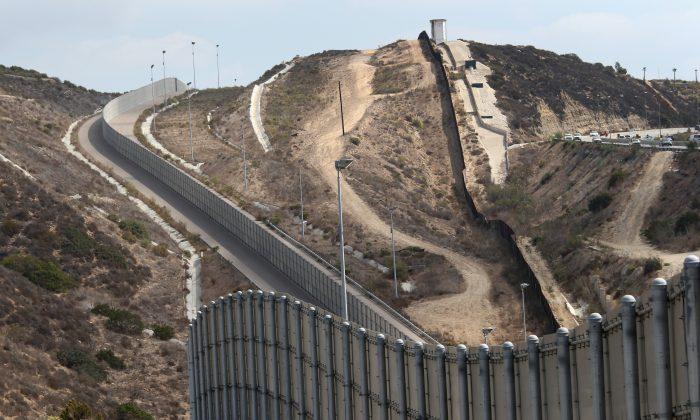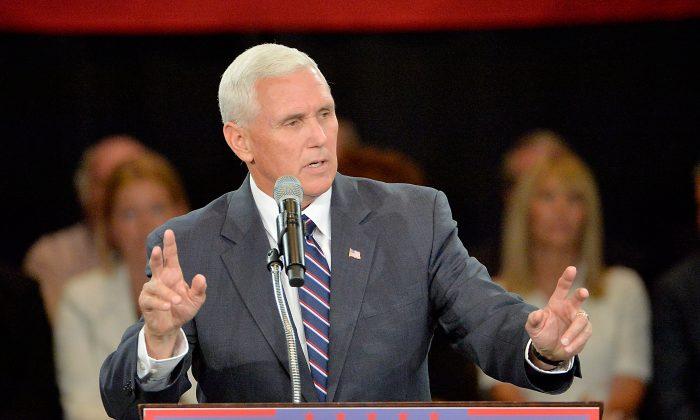One of the most polarizing topics of the 2016 election cycle is immigration reform, particularly when it comes to securing the U.S. southern border.
Republican candidate Donald Trump and Democrat Hillary Clinton both acknowledge that the influx of immigrants since the start of the millennium has had a significant impact on U.S. domestic policy and Mexico–U.S. relations.
An estimated 11.6 million undocumented immigrants are already in the country, which raises concerns about the economic impact on legal citizens.
Both sides have different solutions, and generally, Clinton’s position favors streamlining the process laid down by President Barack Obama—toward easier deportation relief and more pathways to citizenship—while Trump’s position favors increasing the rate of deportation and stricter border security.
Here are each campaign’s main talking points on immigration.
Trump
Border Security
“I will build a great, great wall on our southern border,” proposed Trump at the outset of his campaign.

Over the ensuing months, Trump has made it a refrain in his stump speech, often resulting in the phrase “Build the Wall” turning into a raucous chant at rallies.
Expanding beyond the rallying cry, the wall serves as a reminder of one of Trump’s main campaign themes: “We are the only country in the world whose immigration system puts the needs of other nations ahead of our own. That must change,” reads his campaign website.
Another part of the proposal is that Mexico will pay for the wall via a variety of means: the impounding of remittance payments derived from illegal wages; increased fees on visas issued to Mexican CEOs and diplomats; and increased fees on border crossing cards—of which about 1 million are issued each year to Mexicans (a major source of visa overstay cases).
It also includes increased fees on Mexican NAFTA worker visas (another major source of overstays); and increased fees at ports of entry to the United States. Other options could include increased tariffs or cuts to foreign aid.
All of these fees could be avoided if Mexico makes a one-time payment of $5 billion to $10 billion, which would go toward building the wall and ensuring that trade with the United States would not be disrupted.
“We will not be taken advantage of anymore,” summarizes the Trump campaign.
Deportation
Trump has had a shifting position on the subject of what to do with the country’s 11 million undocumented illegal immigrants.
Early on, the candidate took up the position in interviews of creating a “deportation force,” which would help get undocumented immigrants out of the country.
In speeches and on his website he has highlighted that there are criminals who have entered the country illegally before going on to commit violent crimes against Americans.
Most recently, the rhetoric pivoted, particularly after Trump met with Latino leaders on Aug. 20.
At a Fox News town hall in Austin, Texas, three days later, when questioned if he'd change laws to accommodate longtime, law-abiding residents who have raised children in the United States, Trump answered: “There certainly can be a softening because we’re not looking to hurt people.”
But when Buzzfeed suggested the candidate was shifting his stance, Trump refuted the claims.
“No, I’m not flip-flopping. We want to come up with a really fair, but firm answer,” he told “Fox and Friends” on Aug. 22.
At a rally in Jackson, Mississippi, on Aug. 24, Trump outlined his fair but firm answer, which didn’t signal any softening. He affirmed to Americans that he will protect their jobs from “illegal immigration and a broken visa system.”
He further stated that any immigration policy he supports “must pass three tests:” It must improve jobs and wages, safety, and quality of life for American citizens.
In Fox News interview the same day, he said there would be no amnesty and no citizenship for illegal entrants, and they would have to pay back taxes. “But we [will] work with them,” Trump added.
Clinton

Deportation Relief
Clinton’s immigration reform platform expands on the controversial deportation relief programs proposed by Obama.
At the top of her agenda is defending the Deferred Action for Parents of Americans and Lawful Permanent Residents—known as DAPA—which expands on the Deferred Action for Childhood Arrivals (DACA), a program created by Obama in 2012.
Under DACA, children who arrived under the age of 16 and who lived continuously in the United States from 2007 until then, received a two-year temporary work permit and exemption from deportation. In November 2014, the president wanted to expand DACA to include undocumented immigrants who entered the country before 2010, and other changes.
DAPA would go further, granting deferred action status to parents of a U.S. citizen or permanent resident. Deferred action is not full legal status, but provides a three-year, renewable work permit and exemption from deportation.
Both programs were strongly criticized by Republicans as being too lenient. And Obama was consistently taken to task for overstepping executive powers since he created both via executive action.
Obama’s planned expansion of DACA is now in limbo. A deadlocked 4-4 Supreme Court vote in June blocked DAPA from going into effect after the program was challenged by Texas and 25 other states.
“Hillary believes DAPA is squarely within the president’s authority and won’t stop fighting until we see it through,” reads a statement on her website.
One of the major demographics that would be affected by DAPA are the nearly 5 million so-called DREAMers and parents of American citizens who have trouble getting citizenship status.
DREAMers are undocumented immigrants who arrived as children and who would, depending on age and education level, gain a route to permanent legal status. The term comes from the Development, Relief, and Education for Alien Minors (DREAM) Act that was first introduced in 2001 but never passed. Some similar provisions have been proposed in other forms including in DACA and DAPA.
“We should put in place a simple, straightforward and accessible way for parents of DREAMers and others with a history of service and contributions to their community to make their case and to be eligible for the same deferred action as their children,” she said at a Nevada campaign event in May.
In her campaign, Clinton has also promised to take a harder line on detaining and deporting immigrants considered a “violent threat to public safety,” but to do so in a “humane, targeted, and effective manner.”
Path to Citizenship
Clinton is looking to increase rights and options for undocumented immigrants, and to offer more chances for a “path to citizenship” in a bid to reach out to the Latino vote, one of the fastest growing minority populations in the United States.
Her website pledges to introduce comprehensive immigration reform “with a pathway to full and equal citizenship within her first 100 days in office.”
The position follows a main theme in Clinton’s campaign—appealing to the Latino community with a compassionate and inclusive message of protection.
In a push for Latino support and to drive home the message of inclusion, Clinton showcased speeches from undocumented immigrants hoping to become citizens at the Democratic National Convention last month.
The message has given her an advantage over Trump, with a recent Pew Research poll showing 66 percent of Latinos supporting Clinton and 24 percent supporting Trump.
Clinton’s immigration reform plans also include allowing everyone to buy into the Affordable Care Act regardless of immigration status.
To assist in the pathway to citizenship, Clinton has promised to promote naturalization and alleviate its costs, encourage English-language proficiency, and to make the process as easy to navigate as possible.




